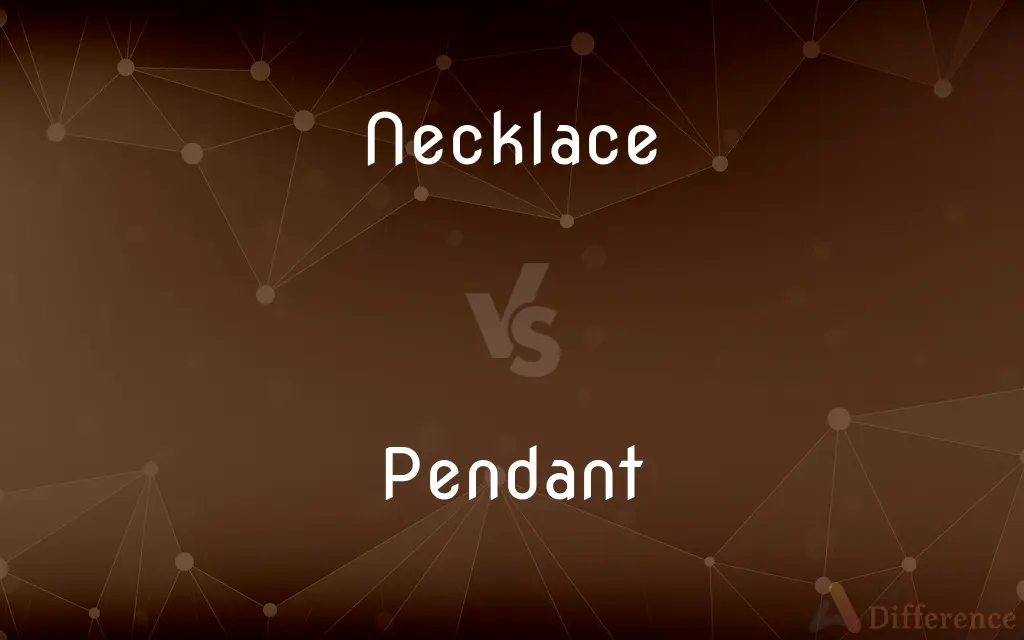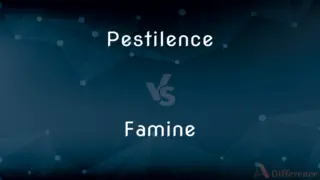Necklace vs. Pendant — What's the Difference?
By Tayyaba Rehman & Urooj Arif — Updated on March 11, 2024
A necklace is a piece of jewelry worn around the neck, often featuring decorative elements or chains, while a pendant is a specific ornament that hangs from a necklace or chain.

Difference Between Necklace and Pendant
Table of Contents
ADVERTISEMENT
Key Differences
Necklaces are versatile pieces of jewelry that adorn the neck, ranging from simple chains to intricate designs incorporating various materials. They can be worn alone or with added ornaments and are integral to various fashion styles and cultural traditions. Pendants, on the other hand, are decorative items that dangle from necklaces, chains, or cords. They add a focal point to the jewelry and often carry personal, symbolic, or aesthetic significance. While necklaces can exist without pendants, pendants require a supporting element, like a necklace or chain, to be worn.
Necklaces often serve as standalone pieces of jewelry, with their design, length, and materials varying widely to suit different tastes and occasions. They can be simple, like a gold chain, or elaborate, with multiple layers and embellishments. Pendants, however, primarily serve to enhance or personalize a necklace, offering an opportunity to display unique jewels, symbols, or motifs. They can be interchanged on the same chain, allowing for versatility and customization.
The materials used in necklaces and pendants can overlap, including metals, gemstones, beads, and more. However, the emphasis in necklaces is often on the overall design and cohesiveness, while pendants focus on the individual charm or ornament's artistry and meaning. This distinction influences the choice of materials, with pendants sometimes featuring more precious or unique elements due to their focal nature.
The cultural and symbolic significance of necklaces and pendants can also differ. Necklaces have been worn throughout history for various reasons, including status, protection, and fashion. Pendants add a layer of personal or cultural meaning to a necklace, often symbolizing beliefs, affiliations, or milestones, such as religious icons, initials, or birthstones.
Despite their differences, necklaces and pendants complement each other in the world of jewelry. A necklace provides the foundation and context for a pendant, which, in turn, adds personalization and emphasis to the necklace. Together, they create a harmonious and expressive piece of adornment.
ADVERTISEMENT
Comparison Chart
Definition
A piece of jewelry worn around the neck.
An ornament that hangs from a necklace, chain, or cord.
Function
Can be a standalone piece or serve as a base for pendants.
Enhances or personalizes a necklace with a hanging charm.
Variability
Varies in length, design, and materials.
Focuses on the design and significance of the hanging piece.
Dependency
Can exist without pendants.
Requires a necklace or chain for wearing.
Significance
Can hold cultural, fashion, or personal value.
Often carries personal, symbolic, or aesthetic meaning.
Compare with Definitions
Necklace
A fashion accessory varying in style and materials.
Her necklace of colorful glass beads complemented her outfit.
Pendant
A hanging ornament on jewelry.
The pendant on her necklace was a small, diamond-encrusted heart.
Necklace
An adornment signifying status or affiliation.
The chief's necklace symbolized his authority.
Pendant
An item of personal significance worn around the neck.
He wore a pendant with his initials engraved on it.
Necklace
A jewelry piece worn around the neck.
She wore a pearl necklace to the gala.
Pendant
A decorative piece attached to a chain or cord.
Her pendant featured a rare gemstone set in gold.
Necklace
A chain or string of decorative elements.
His necklace was made of intricately carved wooden beads.
Pendant
An interchangeable jewelry piece for customization.
She swapped pendants to match her mood.
Necklace
A cultural or traditional ornament.
The ceremonial necklace is passed down through generations.
Pendant
A symbol or motif representing beliefs or affiliations.
Her pendant bore the symbol of her favorite band.
Necklace
A necklace is an article of jewellery that is worn around the neck. Necklaces may have been one of the earliest types of adornment worn by humans.
Pendant
A pendant is a loose-hanging piece of jewellery, generally attached by a small loop to a necklace, which may be known as a "pendant necklace". A pendant earring is an earring with a piece hanging down.
Necklace
An ornamental chain or string of beads, jewels, or links worn round the neck
The harbour with its necklace of lights
A diamond necklace
Pendant
Something suspended from something else, especially an ornament or piece of jewelry attached to a necklace or bracelet.
Necklace
(in South Africa) a tyre doused or filled with petrol, placed round a victim's neck and set alight.
Pendant
A hanging lamp or chandelier.
Necklace
(in South Africa) kill (someone) with a tyre necklace.
Pendant
A sculptured ornament suspended from a vaulted Gothic roof or ceiling.
Necklace
An ornament worn around the neck.
Pendant
One of a matched pair; a companion piece.
Necklace
Something felt to resemble this neck ornament, as in shape
A necklace of hundreds of tiny islands.
Pendant
Hanging down; dangling; suspended.
Necklace
An article of jewelry that is worn around the neck, most often made of a string of precious metal, pearls, gems, beads or shells, and sometimes having a pendant attached.
Pendant
Projecting; overhanging.
Necklace
(figuratively) Anything resembling a necklace in shape.
A necklace of coral islands
Pendant
Awaiting settlement; pending.
Necklace
(South Africa) A device used in necklacing (an informal execution); a rubber tyre that is filled with petrol. It is placed around the victim's chest and arms, and set on fire.
Pendant
Variant of pendent1.
Necklace
(South Africa) To informally execute by necklacing; by setting on fire a petrol-filled rubber tyre which has been put around the bound victim's neck.
Pendant
(architecture) A supporting post attached to the main rafter.
Necklace
A string of beads, etc., or any continuous band or chain, worn around the neck as an ornament.
Pendant
A piece of jewellery which hangs down as an ornament, especially worn on a chain around the neck.
Necklace
A rope or chain fitted around the masthead to hold hanging blocks for jibs and stays.
Pendant
The dangling part of an earring.
Necklace
Jewelry consisting of a cord or chain (often bearing gems) worn about the neck as an ornament (especially by women)
Pendant
(nautical) A short rope hanging down, used to attach hooks for tackles; a pennant.
Pendant
(fine arts) One of a pair; a counterpart.
One vase is the pendant to the other vase.
Pendant
(US) The stem and ring of a watch, by which it is suspended.
Pendant
A lamp hanging from the roof.
Pendant
An ornament of wood or of stone hanging downwards from a roof.
Pendant
A long narrow flag at the head of the principal mast in a royal ship.
Pendant
(obsolete) An appendix or addition, as to a book.
Pendant
Testicles.
Pendant
(obsolete) A pendulum.
Pendant
Something which hangs or depends; something suspended; a hanging appendage, especially one of an ornamental character, as to a chandelier or an eardrop; also, an appendix or addition, as to a book.
Some hang upon the pendants of her ear.
Many . . . have been pleased with this work and its pendant, the Tales and Popular Fictions.
Pendant
An ornamental object or piece of jewelry with a hook so that it can be hung from a chain around the neck.
Pendant
A hanging ornament on roofs, ceilings, etc., much used in the later styles of Gothic architecture, where it is of stone, and an important part of the construction. There are imitations in plaster and wood, which are mere decorative features.
Pendant
One of a pair; a counterpart; as, one vase is the pendant to the other vase.
Pendant
A pendulum.
Pendant
The stem and ring of a watch, by which it is suspended.
Pendant
An adornment that hangs from a piece of jewelry (necklace or earring)
Pendant
Branched lighting fixture; often ornate; hangs from the ceiling
Common Curiosities
Can a pendant be worn with any necklace?
Pendants can typically be attached to various necklaces, depending on the design.
Do all necklaces come with pendants?
Not all necklaces come with pendants; some are standalone pieces.
Are pendants interchangeable?
Many pendants are designed to be interchangeable, allowing for customization.
Can pendants have functional purposes?
Some pendants serve functional purposes, such as holding small items or acting as a locket.
Can necklaces be part of cultural or religious practices?
Yes, necklaces often have cultural, spiritual, or religious significance.
Are pendants suitable for all ages?
Pendants are versatile and can be suitable for all ages, depending on the design.
Can a necklace be worn without a pendant?
Yes, necklaces can be worn alone without pendants.
How do you choose the right necklace for a pendant?
The choice depends on the pendant's weight, style, and the desired overall look.
Is there a standard length for necklaces?
Necklace lengths vary, ranging from chokers to long opera lengths.
Do pendants always hang in the center of a necklace?
Pendants typically hang in the center, but placement can vary.
Are pendants always made of metal?
Pendants can be made from various materials, not limited to metals.
Can multiple pendants be worn on one necklace?
Yes, some necklaces are designed to hold multiple pendants.
How do you care for necklaces and pendants?
Care depends on the materials, but generally includes gentle cleaning and proper storage.
Can necklaces and pendants be customized?
Both necklaces and pendants offer opportunities for customization.
Share Your Discovery

Previous Comparison
Pestilence vs. Famine
Next Comparison
Dealer vs. SupplierAuthor Spotlight
Written by
Tayyaba RehmanTayyaba Rehman is a distinguished writer, currently serving as a primary contributor to askdifference.com. As a researcher in semantics and etymology, Tayyaba's passion for the complexity of languages and their distinctions has found a perfect home on the platform. Tayyaba delves into the intricacies of language, distinguishing between commonly confused words and phrases, thereby providing clarity for readers worldwide.
Co-written by
Urooj ArifUrooj is a skilled content writer at Ask Difference, known for her exceptional ability to simplify complex topics into engaging and informative content. With a passion for research and a flair for clear, concise writing, she consistently delivers articles that resonate with our diverse audience.
















































